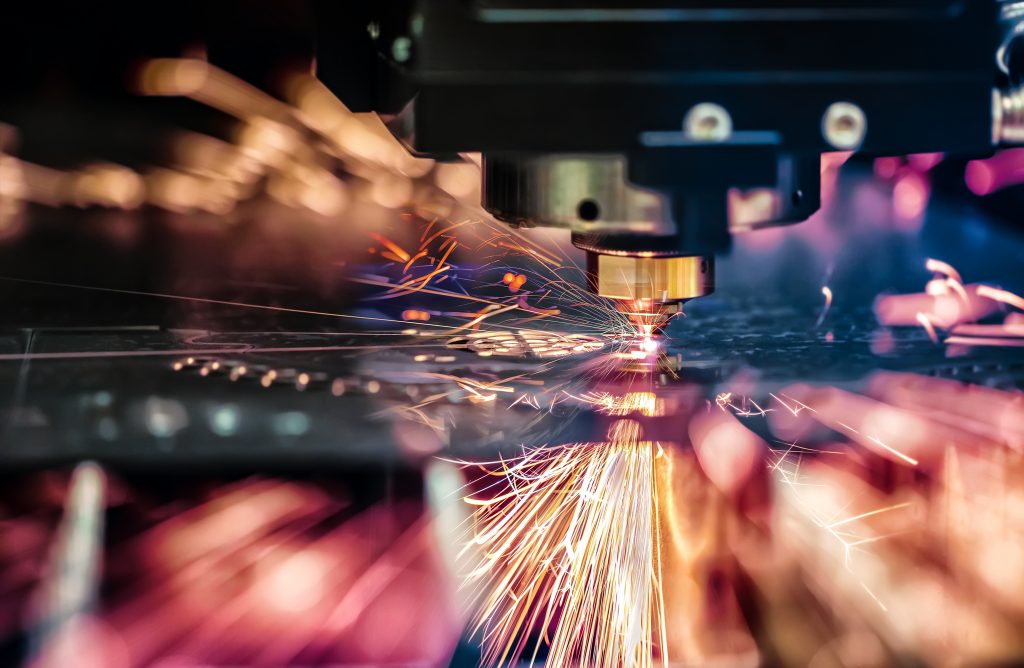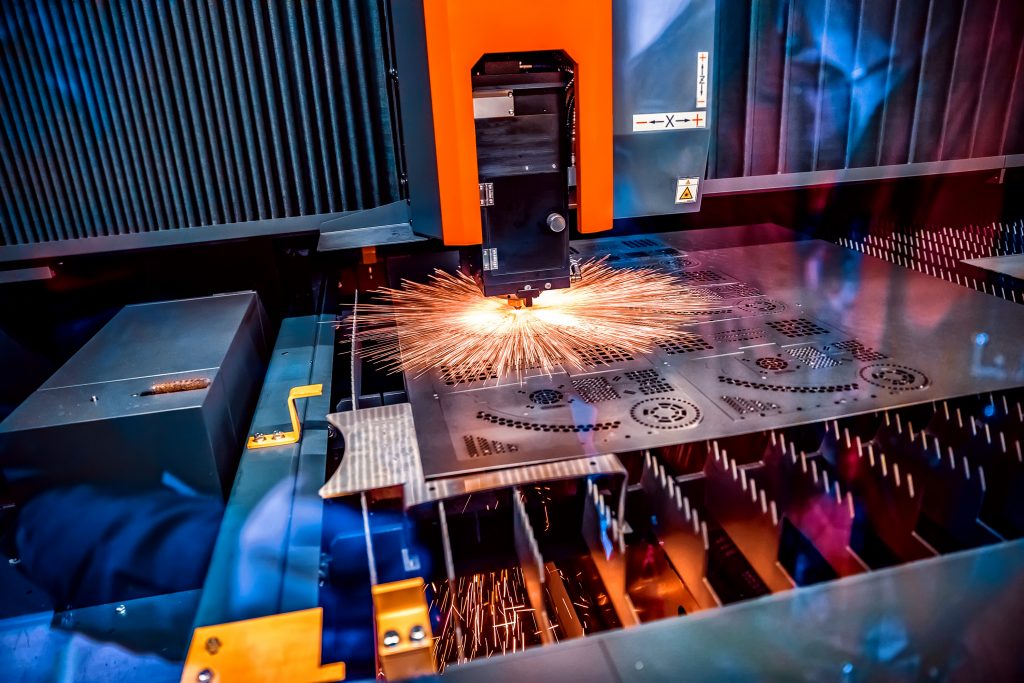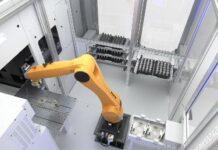Laser cutting and water jet cutting—as a manufacturer, you likely already know what both of these are, or have maybe even used them in your own business. While both cutting processes have been around for a few decades now, they are both considered relatively new, and only continue to grow in popularity.
Technology has made significant progressions in both laser and water cutting machines over the years. As a result, Leverwood Knife Works is excited to already be a cut above the rest by implementing a new laser cutting machine into our workflow processes. In this post, we want to go over laser cutting and water jet cutting and show you why we chose to go with laser cutting to help improve our products.
 How Does Laser Cutting Work?
How Does Laser Cutting Work?
If you’re picturing laser beams or lightsabers from science fiction, you’re actually not too far off. Have you ever taken a magnifying glass out in the bright sun and burned a small hole in something with it? Using a concentrated beam of light as you do with a magnifying glass, is actually how laser cutting works.
A laser cutter takes a laser beam—“a column of very high-intensity light of a single wavelength” invisible to the naked human eye—and using mirrors, refocuses the beam so it concentrates into a single pinpoint. By focusing the laser, the light becomes superheated in one spot and cuts objects as close as .006 inches (depending on cutting speed).
What Are the Advantages of Laser Cutting?
There are several reasons as to why laser cutting has become so popular and common in the last few years, mostly due to its advantages in lowering lead times. At Leverwood, we use a new state-of-the-art CNC laser metal cutting machine. This new laser cutting machine makes more precise cuts than other equipment and creates even more accurate blades. Here are a few reasons why we recommend taking advantage of laser cutting services.
Incredible Precision
More precise than its waterjet cutting counterpart, laser cutting is where you’ll want to turn to for finely detailed projects. As we mentioned earlier, laser cutting can cut as small as .006 inches, while waterjet cutting only goes to .02 inches.
Lower Risk of Contaminating Materials
Laser cutting offers the advantage of not having the cutting tool come into direct contact with the material. Depending on how sensitive the material you’re working with is, that can be a huge advantage. Without that tool-to-material contact, there is a much lower risk of contaminating your material.
Lowered Risk of Deformation
While a lot of common materials need heat to be cut, a lot of the times, the material can melt and cause deformation. When you use laser cutting for your project, the heated area is so small that you significantly reduce possible distortion in your materials.
What Are the Disadvantages of Laser Cutting?
There are a lot of advantages to utilizing laser cutting services, but it may not be ideal for every single project. There are a few times where you may need to turn elsewhere when you need your materials cut with accurate precision.
Metal Combinations with Different Melting Points
If your project has two or more types of metal combinations, you have to take into consideration if each metal has a different melting point. If so, you may not get the precision or results that you’re looking for.
Can’t Cut Highly Reflective Metals
When cutting highly reflective materials, a laser metal cutting machine may not be your best route. Materials like copper, bronze, brass, aluminum, gold, and silver and can reflect up to 95 percent of visible light. Since laser cutting uses light and mirrors, the reflecting can cause problems for cutting.
 How Does Water Jet Cutting Work?
How Does Water Jet Cutting Work?
Now that we’ve gone over exactly how laser cutting works, we’ll discuss another popular cutting method—water jet cutting.
If you’ve ever been at the wrong end of a high-power hose or pressure washed the side of a house, you’ll already have a vague idea of what water jet cutting is. Water jet cutting takes extremely high pressures of water that are concentrated into a single stream to cut various materials. Next to laser cutting, water jet cutting is the next most precise way of getting finely detailed and accurate cuts on your materials.
What Are the Advantages of Water Jet Cutting?
Just like laser cutting, water jet cutting is an extremely accurate manufacturing process. As we mentioned earlier, water jet cutters can cut sizes as small as .02 inches. Here are a few more of its well-known advantages.
Cuts Almost Any Material
Water jet cutters can cut almost any material that traditional cutting methods can, as well as a few more. Whether it’s stone, metals, or glass, there aren’t many materials that water jets can’t cut. The only few materials a water jet cannot cut are diamonds (they’re too hard), tempered glass (too fragile), and a few types of advanced ceramics or composite materials for various reasons.
No Heat Produced
Remember one of the issues we mentioned previously about laser cutters sometimes having problems with melting materials that have different melting points? This is where water jets come to the rescue. Since water jet cutters use significantly less heat and don’t overheat any areas close to where you’re cutting, your materials remain intact and undamaged.
Considered “Green Technology”
Because water jet cutters use…well, water, to cut materials, these machines do not create any hazardous waste. It also allows for scrap metal to be recycled and uses very little water when cutting.
What Are the Disadvantages of Water Jet Cutting?
While this method of metal fabrication is still commonly used, there are a few disadvantages to water jet cutting that we want to bring up. It’s because of these reasons (and a few others) that have Leverwood consistently turning to laser cutting almost every time.
Much Longer Cutting Time
One of the biggest reasons we love our laser cutter is that the machine loads and unloads material automatically and cuts much faster than any other method. When we can cut faster, we can afford more capacity for projects and get our customers a much quicker delivery time. Water jet cutting is slower than the laser cutting method, and we’re always looking to work as efficiently as possible.
Less Accuracy with Thicker Materials
When you use water jet cutting, the area closest to the stream of water is going to receive the most force. Because of this, thicker materials can sometimes cut less accurately since the stream is further away from the point of impact. The result is that the cuts sometimes look slightly more diagonal than giving a clean, straight line.
Potential for More Risks and Noise Pollution
Like with most metal fabrication or industrial processes, anyone that operates a water jet cutting machine needs to be conscious of the safety risks. Ear protection will be required due to the surprisingly high noise pollution that it causes, as well as eye protection (both of which are not always necessary with laser cutting but still recommended).
About Leverwood Knife Works
Looking for the Best Blades and Cutting Processes for Your Business? No matter what you need cut, you can rely on Leverwood Knife Works to provide you with the most precise, custom, and standard industrial knife blades on the market. Leverwood blades are produced using only the best materials and processes available to ensure your blades are durable and accurate. Maximize your efficiency and contact Leverwood for more information on what they can do for you and your business.



















